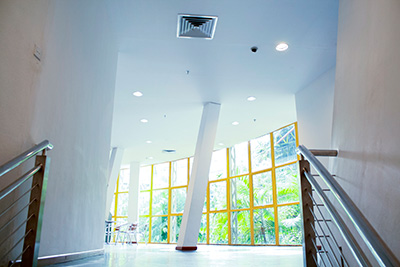The best way for any individual, and especially any company, to save energy is to start by monitoring energy usage. Once you know which systems in your facility use the most energy, it will be much easier to come up with an energy-saving plan. However, many facilities would benefit from following the energy-saving tips below (with or without an energy audit).

1. Changing Shifts to Avoid Peak Energy Costs(8)
- In Ontario, there are three time-of-use periods (peaks) for energy demand.
- Off-Peak: Demand is low. Less expensive electricity sources are used
- Mid-Peak: Cost and demand of energy are moderate
- On-Peak: Demand is highest and more expensive production methods are used
- In the winter, there are two daily peaks: in the morning when people get up, and in the evening when they get home from work. In summer, demand peaks in the afternoon when air conditioners are running on high. Demand and prices are lower overnight, on weekends and statutory holidays.
- To figure out pricing for each time-of-use period, and typical on, mid and off-peak hours, visit your government energy website.
- Knowing when your local on-peak hours are can help you reduce energy costs. By knowing when electricity costs are highest, you can adjust employee shifts and machine operating times to mid or off-peak hours when possible.
2. Daylighting (5)
- Daylighting uses skylights and windows to bring natural light into your building. The latest energy efficient windows, as well as advances in lighting design for new builds, reduce the need for artificial lighting during prime daylight hours and won’t cause heating or cooling issues.
- For already existing structures, adding windows to the North-facing wall of your building, and skylights, will provide relatively even light, with little glare and almost no unwanted summer heat gain.

 3. Lighting Controls and Energy-Efficient Lighting
3. Lighting Controls and Energy-Efficient Lighting
- Energy consumption from lighting ranges from 35-75% of a business’s total energy usage (3), so energy-efficient lighting and technology is a must.
- Lighting controls (7) such as dimmers, motion sensors, occupancy sensors, photosensors, and timers can greatly reduce energy consumption and extend the life of your lighting.
- Dimmers allow for variation in indoor light levels. Dimming lights reduce their wattage and output, decreasing energy consumption.
- Motion Sensors automatically turn lights on when motion is detected, and then turn them off a short time later. Almost exclusively used outdoors, where constant lighting isn’t necessary.
- Occupancy Sensors detect activity within a specific area. As long as sensors can properly detect occupants and activity, lights stay on when a room is occupied, and turn off when the last occupant has left. Within occupancy sensors, there are Ultrasonic (sound) and Infrared (heat and motion) sensors.
- Timers are programmable modules that allow you to choose what hours of the day lighting is on. They can be used to automatically turn lights on at specified times, turn them off after a certain amount of time or leave them on only certain hours of the day.
- Manual timers plug into an electrical outlet to control lamps and strings of light.
- In-wall programmable digital timers automate built-in lighting.
- As for energy-efficient lights, LED lighting uses at least 75% less energy, and lasts 25 times longer than incandescent lighting. LED is one of today’s most energy-efficient and quickly-developing lighting technologies. Quality LEDs last longer, are more durable and offer comparable (and often better) light quality. In short, switching to LED is a sure-fire way to cut energy costs (6).
4. Building recommissioning
- Recommissioning is a process for investigating, analyzing and optimizing the performance of building systems already in place, and implementing improvement measures to ensure continued proper performance. This means undertaking regularly scheduled reviews of equipment and building systems to ensure they are at optimal operating capacity, and fixing any issues as they arise to ensure they continue operating optimally (11).
- This is especially important for HVAC systems. Metering and monitoring of the HVAC system can measure system efficiency and help to identify leaks and other inefficiencies (10).
- Studies have shown that the recommissioning process can lead to 10-15% reduction in annual energy costs (10).
- Another system that recommissioning is important for is building chillers. If a chiller is old, it may not be operating properly. Replacing an older chiller with a new, energy-efficient one can lower maintenance and electricity costs. These savings quickly offset the cost of a new unit (3).

5. Reduce the load put on the HVAC System
- Keep air vents clear of any obstructions, such as papers, office supplies, equipment, etc. Blocked vents cause 25% more energy to be put into pumping air into a space (9).
- Proper sealing of doors, windows and roofs minimize heat/cold escaping from the building, and prevents cold/hot air from entering (in winter and summer respectively).
- Using a programmable thermostat allows for optimal usage of the HVAC system. It allows you to program automatic adjustments in temperature in different areas at different times, to ensure no air is being circulated in unoccupied areas (2).
- Cogeneration: increases energy efficiency, and decreases the load on the HVAC system by re-directing the waste heat of power production to heat water and warm spaces (3).
6. Service Compressors and Motors
- Compressors (4):
- Fix Existing Leaks
- Prevent New Leaks: Dirty piping causes corrosion, greatly increasing the number of leaks. Dried and properly filtered compressed air keeps piping clean.
- Reduce Pressure: Run at required pressures and no higher. If there is a drop in pressure, fix the issue to re-establish proper system pressure.
- Emphasize Proper Maintenance: Scheduled routine checks and maintenance ensure optimal functioning, and therefore efficient energy uses.
- Change All Filters in the System Systematically: If all filters are changed on schedule, changes in pressure should not occur, allowing for proper usage of the machine, and again efficient energy usage.
Motors: Typically, motors are installed and kept running but seldom maintained or replaced. However, if a motor is old, a newer model will likely have a better design, improved materials and will yield energy savings (3).

7. Turn Off Equipment Not in Use (12)
- As humans, we are forgetful. So even something as simple as turning off equipment when we don’t need it on can be difficult. Additionally, all electronic devices, so long as they are plugged in, draw power even when switched off. Thankfully, there are a few things we can do.
- Use a Built-in-Timer Power Bar. The timer can be set to turn off when you know items plugged in won’t be in use.
- Use an Auto-Off Power Bar: When a central device that is plugged in is turned off, the power bar will automatically shut down the power to other connected devices. It is best to use this type of power bar with items that are almost exclusively used in tandem.
- Use occupancy sensors: integrate the lighting system occupancy sensors into the HVAC system (1) to ensure air is not being circulated to unoccupied areas.

8. Motivate All Employees to Take Part in and Responsibility for Energy Savings
- Make an energy-savings plan and allow all employees to contribute to it. When they see their ideas are put in an action plan, it will motivate them to closely follow the action plan and laid out procedures to help reduce energy consumption.
- Hold energy-saving contests. Encourage employees to honestly and accurately track their energy-usage in the workplace, and award employees who have provenly reduced their consumption.
- Ensure all employees are taught about new energy-saving equipment, sensors, and practices. Only with accurate and proper knowledge can employees really understand the why and apply an energy-saving mindset.
Resources:
- Biz Energy: “Maximizing energy efficiency in industrial buildings”
- BLOOM: “Energy Saving Tips for the Commercial & Institutional Sectors”
- Clean Techies: “Energy Savings Tips for Commercial Buildings”
- Compressed Air & Gas Institute: “10 Steps to Savings”
- Energy.gov: “Daylighting”
- Energy.gov: “LED Lighting”
- Energy.gov: “Lighting Controls”
- Energy.gov: “Smart Meters and Time-of-Use Prices”
- Energy Star: “Energy-saving tips for everyone”
- Industrial Controls: “10 Energy Efficiency Tips For Commercial Buildings”
- Natural Resources Canada: “Existing Buildings: Recommissioning”
- saveONenergy: “Use a power bar with a built-in timer or auto-shutoff”
